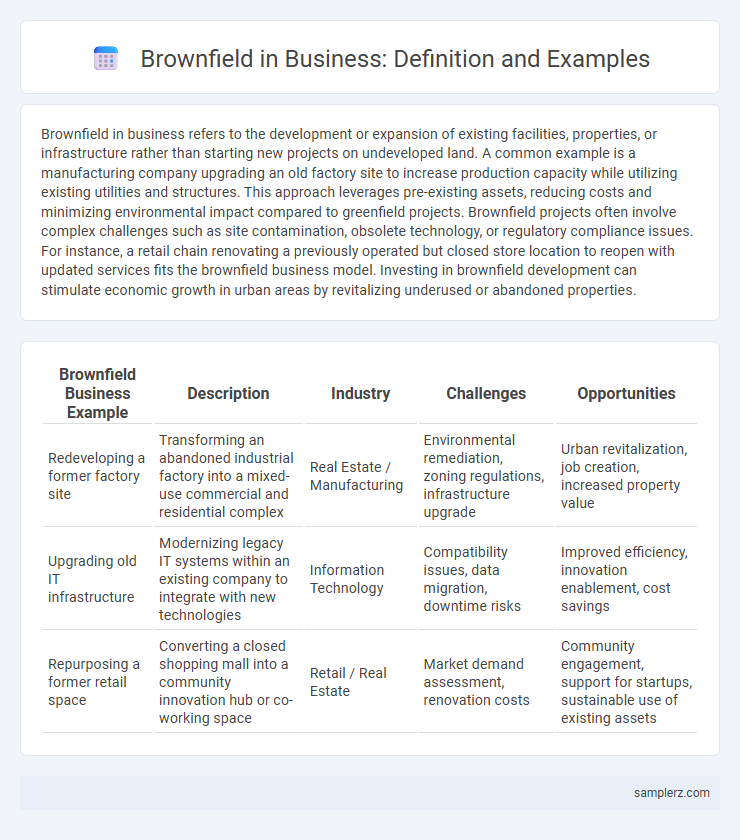Brownfield in business refers to the development or expansion of existing facilities, properties, or infrastructure rather than starting new projects on undeveloped land. A common example is a manufacturing company upgrading an old factory site to increase production capacity while utilizing existing utilities and structures. This approach leverages pre-existing assets, reducing costs and minimizing environmental impact compared to greenfield projects. Brownfield projects often involve complex challenges such as site contamination, obsolete technology, or regulatory compliance issues. For instance, a retail chain renovating a previously operated but closed store location to reopen with updated services fits the brownfield business model. Investing in brownfield development can stimulate economic growth in urban areas by revitalizing underused or abandoned properties.
Table of Comparison
| Brownfield Business Example | Description | Industry | Challenges | Opportunities |
|---|---|---|---|---|
| Redeveloping a former factory site | Transforming an abandoned industrial factory into a mixed-use commercial and residential complex | Real Estate / Manufacturing | Environmental remediation, zoning regulations, infrastructure upgrade | Urban revitalization, job creation, increased property value |
| Upgrading old IT infrastructure | Modernizing legacy IT systems within an existing company to integrate with new technologies | Information Technology | Compatibility issues, data migration, downtime risks | Improved efficiency, innovation enablement, cost savings |
| Repurposing a former retail space | Converting a closed shopping mall into a community innovation hub or co-working space | Retail / Real Estate | Market demand assessment, renovation costs | Community engagement, support for startups, sustainable use of existing assets |
Understanding Brownfield Projects in Business
Brownfield projects in business refer to upgrading or redeveloping existing facilities or infrastructures, such as renovating outdated manufacturing plants or modernizing legacy IT systems. These projects involve managing challenges like integrating new technologies with existing operations while minimizing downtime and costs. Understanding brownfield initiatives helps businesses optimize resources, reduce environmental impact, and accelerate project timelines by leveraging established assets.
Key Characteristics of Brownfield Investments
Brownfield investments involve entering existing business operations, often requiring the renovation or expansion of facilities rather than starting from scratch. Key characteristics include leveraging established infrastructure, navigating pre-existing regulatory and environmental conditions, and managing integration with current operations to reduce time-to-market and initial costs. These projects typically face challenges like legacy system compatibility and potential hidden liabilities but benefit from quicker operational startup compared to greenfield investments.
Benefits of Brownfield Expansion for Companies
Brownfield expansion allows companies to revitalize existing facilities, reducing construction costs and minimizing environmental impact compared to greenfield projects. Leveraging established infrastructure accelerates market entry and lowers operational risks, enhancing competitive advantage. This approach optimizes resource utilization while improving sustainability and compliance with local regulations.
Notable Examples of Brownfield Ventures
Notable examples of brownfield ventures in business include the redevelopment of former industrial sites such as the London Docklands and Detroit's Motor City, where obsolete manufacturing facilities were transformed into mixed-use developments combining residential, commercial, and recreational spaces. These projects leverage existing infrastructure to reduce costs and environmental impact while revitalizing urban areas and attracting new investment. Brownfield ventures showcase sustainable urban regeneration by balancing economic growth with environmental remediation and community development.
Brownfield vs Greenfield: Strategic Differences
Brownfield projects involve modifying or upgrading existing business infrastructure, such as expanding a manufacturing plant or renovating an outdated office space, whereas Greenfield projects start from scratch on undeveloped land with no constraints from prior work. Strategic differences include risk management, with Brownfield initiatives often facing higher regulatory hurdles and integration challenges but benefiting from existing assets and market presence. Conversely, Greenfield developments allow full customization and innovation freedom but demand significant capital investment and longer time to market.
Case Study: Brownfield Success in Manufacturing
The case study of a brownfield success in manufacturing highlights how a legacy automotive plant was revitalized through strategic investment and modern technology integration, increasing production efficiency by 35%. By repurposing existing infrastructure and adopting lean manufacturing principles, the facility reduced operational costs while minimizing environmental impact. This transformation demonstrates how brownfield projects can drive sustainable growth and competitive advantage in the manufacturing sector.
Challenges in Brownfield Business Development
Brownfield business development often encounters challenges such as legacy system integration, regulatory compliance hurdles, and high initial capital expenditure. Companies must navigate outdated infrastructure and unpredictable environmental liabilities while aligning new technologies with existing operations. Managing stakeholder resistance and ensuring scalability within constrained environments further complicate successful brownfield project execution.
Environmental Considerations in Brownfield Projects
Brownfield projects in business often involve redeveloping former industrial sites where soil and groundwater contamination must be addressed through environmental assessments and remediation strategies. Incorporating sustainable practices such as phytoremediation, soil washing, and vapor intrusion mitigation ensures compliance with regulatory standards and minimizes ecological impact. Successful brownfield redevelopment enhances property value while protecting public health and promoting long-term environmental stewardship.
Financing Options for Brownfield Investments
Brownfield investments often require tailored financing options due to existing infrastructure and environmental remediation costs. Common financing methods include specialized loans, government grants targeting redevelopment projects, and private equity focused on brownfield revitalization. Leveraging public-private partnerships can also mitigate risks and enhance capital availability for brownfield business ventures.
Future Trends in Brownfield Business Strategies
Brownfield business strategies increasingly leverage advanced technologies such as AI, IoT, and sustainable practices to optimize existing industrial sites and improve operational efficiency. Future trends emphasize integrating digital twins and predictive analytics to enhance asset management and reduce environmental impact. Companies adopting these innovations position themselves for competitive advantage by revitalizing underutilized properties with smart, eco-friendly solutions.

example of brownfield in business Infographic
 samplerz.com
samplerz.com